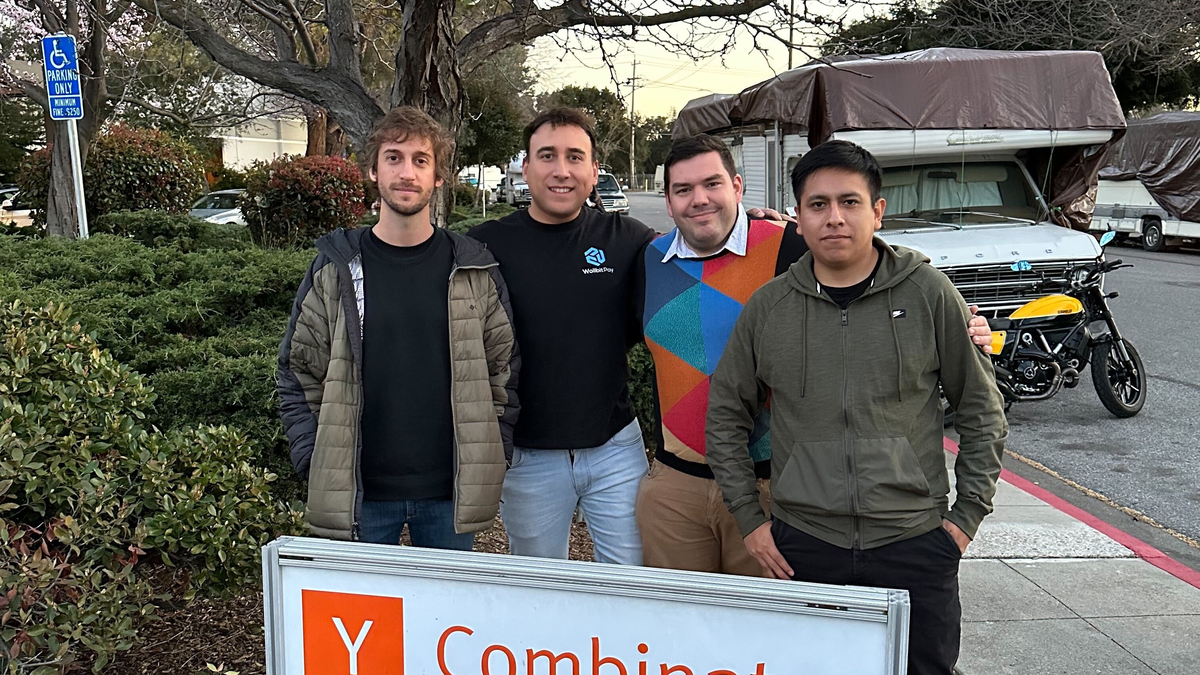All these data arise from a survey carried out by Wallbitthe first digital bank created specifically to meet the needs of remote workers in Latin America. And that is where the brand new financial entity of Argentine origin seeks to develop its business model.
Wallbit was founded by four 30-year-old Argentine programmers who worked for companies abroad: Rodrigo Vidal, Tomás Bruzza, Martín Tito Gira and Braian Fritz.
Tired of the poor and limited experience offered by international payment platforms, they decided gather US$200,000 from your savings as an investment to build what they call the first “neobank” dedicated to remote workers.
It started operating in April of this year in Argentina, Colombia and Mexico and it already has 10,000 users, most of them Argentine.
From April to date has processed more than US$30 million in transactions and they estimate that this figure will exceed US$100 million by the end of 2024. In addition, they plan to end this year with a turnover of more than US$600,000.
“We want bank people directly in the United Statesgive them an account, a card, an investment account. And offer the tools so that our users can collect and bring their money simply and cheaplybut we also look for that they can invest all their savings and build wealth,” explained Rodrigo Vidal, CEO and founder of Wallbit in an interview with Scope.
Journalist: What does it mean that Wallbit is a neobank? What makes it different from well-known digital banks?
Rodrigo Vidal: It is a digital bank, but technically it is a real bank called Bangor Savings Bank and it is in the northeast of the United States, near Boston. When a user opens their account in our application it is as if they had traveled to Boston with their passport to open an account at the branch. We simplify that onboarding. The user is registered, documentation is requested, the person’s identity is validated. Bangor receives the documentation and opens the account. And then it is managed from our application. Our activity is regulated by the Bank Secretary Act and the SEC, which is equivalent to the CNV of Argentina.
This is equivalent, for example, to when a virtual wallet is launched in Argentina. It generally works with the industrial bank, BIND, which is a bank that works a lot with these wallets. Then obviously there are other digital wallets that evolved and built their own bank.
Wallbit rodrigo-vidal.jpg
Rodrigo Vidal, CEO and co-founder of Wallbit.
Q: What is the operation like for an Argentine remote worker to collect their salary and withdraw bills in the country?
RV: Argentina is a special case in the region. Although we have a special closeness for being Argentine, because it is the place where we have the greatest number of users, what we are looking for is for it to be a more global, regional product.
But each country has its particularities. For example, in Colombia and Mexico you cannot have savings accounts in dollars. Something that is very common here is not allowed there. That is why someone from Colombia highly values the possibility of accumulating dollars in an account outside their country. And the Argentine seeks to get the physical ticket.
In the case of Argentina, the restrictions are always mostly exchange rate, due to the stocks and everything we already know. Today from Wallbit you can collect a salary, you can withdraw it directly in pesos, at a price that is similar to the MEP dollar, close to the blue price. You can also send dollars to a savings account at a traditional bank in Argentina. And there the ticket is withdrawn at the cashier.
The commission paid on these operations is 0.5%. If someone goes to a cave to do the same thing, you have to pay 3 to 5 percent. And on top of that, you have to take into account the risks that an operation with this type of financial institution entails.
Q: What is the modality that Argentines use the most?
RV: The reality is that the majority of Argentine users make withdrawals in pesos directly. We conduct surveys among users to understand what is behind this behavior. And something we see is that whoever withdraws a dollar bill is because they have to pay something in dollars, like rent. Or because you are investing in some property. But generally for daily operations they choose to withdraw the pesos.
If they withdraw pesos, they can transfer it to any virtual wallet, even Mercado Pago, since within Wallbit the user can add their CVU of wallets, or the CBU of a traditional bank, even of a crypto wallet. The commission applied is the same for transferring dollars. The only difference is that it is applied to the exchange rate. For example, if we get the dollar at 1,200 pesos, we take it from the user at 1,193 pesos. This is how the fee is charged.
Q: In which countries are you operating and where do you have the most users?
RV: We are in Mexico, Colombia and Argentina. And before the end of the year we will be in Chile, Uruguay, Peru, Ecuador and Brazil. The largest number of our 10,000 current users are in Argentina. And it’s something that happened naturally because we live here. And we know very closely what the problems of remote workers here are. And we are Wallbit users. We have users in Colombia and Mexico who arrived simply by word of mouth. The users themselves who are known for remote work are recommending our solution.
The user growth we have projected is 40% monthly. The main acquisition channel is the word of mouth that I mentioned before. Very few people come for any advertising on the networks.
Q: It seems like a paradox that a 100% digital bank, in the era of social networks and connectivity, has word of mouth as the main method to add customers.
RV: Literally. But this is no coincidence. What we are looking for is for the product to be the protagonist of growth, for it to truly surpass the rest of the options available. When someone switches to our product it has an impact on our growth. And we seek to maintain close contact with the user.
Many remote workers have the exact same problem, so it’s a niche that’s very easy to find. Someone who works outside and earns in dollars has friends in the same situation.
And also because when you place free ads it is more difficult to segment it so that it appears exactly to the people you are looking for. That’s why this seems strategic to us. Take care of clients who arrive because we are aware of the cascading effect that this means. It is much stronger than placing an ad on Instagram, which anyone ends up seeing. It’s almost like a shot in the air.
Q: What is the difference you offer compared to the competition?
RV: There is more than one. All remote workers ended up using platforms that already existed, combining them to survive. For example, Paypal, Payoneer, Wise, among others. None were created with the needs of remote workers in mind. And that combination means ending up paying very high costs, because each one takes a percentage out of you and makes you lose a lot of money. We founded Wallbit thinking about a specific user, because we suffered it firsthand for several years.
Paypal, for example, is not interested if the user has to withdraw from Mercado Pago or pay the rent. Yes to us. And that closeness distinguishes us.
Don’t even talk to support if you have a problem. With these platforms, the user has to call an international call center and speak English. We provide support in Spanish and with someone who is Argentine. That is a huge differential when it comes to having any inconvenience or doubt.
Q: What is another differential that attracts investors who put capital into Wallbit?
RV: Beyond this local point of proximity, something that investors value highly is that we offer the user the possibility of making investments with their money. It is a very big differential at the product level. When we talk about remote workers we always stop at the point of seeing how to withdraw funds. But the investor has a much more long-term vision of things because he knows that this will be resolved at some point, as is happening now.
The investment part is more interesting because today this product is something that the remote worker does not have access to, especially if he ends up accumulating dollars in cash. When it comes to professionals, they end up keeping the dollars at home or in a safe deposit box.
After several years, what many people do is invest in a property from the well. Or they invest in cryptocurrencies because this option is now widely available through exchanges. We have the proposal to invest in the United States stock market, to generate interest in dollars.
That’s where investors see a clear Wallbite differential in the long term. Especially because if the user is able to trust the platform and invest their savings, the bond that is generated between the company and the client is much stronger.
Q: What was the capital integration process like and how will it continue?
RV: Last year Wallbit became one of the few companies of Argentine founders that received investment from Y Combinator, the largest accelerator in the world that has also invested in companies such as Airbnb, Rappi and Dropbox.
Key investors also include Rebel Fund, Goodwater Capital, Zentani Capital, Maiora Capital, and several industry angel investors. In the first stage we managed to raise US$1.5 million in the seed series and we plan to extend the round in the coming months to accelerate our growth.
Source: Ambito
I am a 24-year-old writer and journalist who has been working in the news industry for the past two years. I write primarily about market news, so if you’re looking for insights into what’s going on in the stock market or economic indicators, you’ve come to the right place. I also dabble in writing articles on lifestyle trends and pop culture news.




